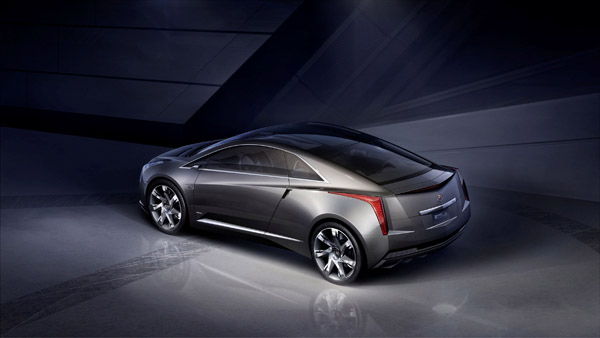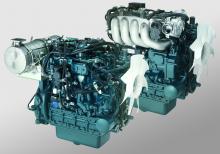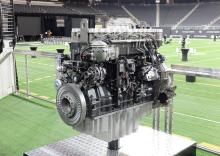There is an array of future vehicle solutions in development - Mike Woof reports. Ever since Henry Ford's Model T showed that the motor car could provide transport for ordinary people rather than being an exclusive toy of the rich, vehicle numbers have exploded. In every country around the world, vehicle ownership continues to grow.

The Cadillac ELR will feature an electric propulsion system made up of a T-shaped lithium ion battery, an electric drive unit, and a four-cylinder engine-generator
There is an array of future vehicle solutions in development - Mike Woof reports
Ever since Henry Ford's Model T showed that the motor car could provide transport for ordinary people rather than being an exclusive toy of the rich, vehicle numbers have exploded. In every country around the world, vehicle ownership continues to grow.There are however two key problems to be faced. Oil reserves are finite and in the coming century, petrol and diesel will become prohibitively expensive for use as fuel and forecasts suggest this will happen in the next 20-25 years. Furthermore, climate change is occurring and vehicle use plays a part. While this last issue is a topic of much debate it is worth remembering that for all the eminent scientists who disagree with the concept of climate change, they are outnumbered 100:1 (or perhaps more) by those who do.
In light of these dual problems, vehicle manufacturers are committed to investing in a wide range of different power-train solutions in a bid to reduce overall fuel use and emissions.
Hybrid vehicles certainly offer benefits in terms of reduced fuel consumption. These feature sophisticated constantly variable transmissions and economy can be improved further by the use of lightweight materials in vehicle design such as manganese alloys, composites and plastics. But hybrids running on fossil fuels, even the latest plug-in or range-extended hybrids, are essentially a stopgap technology.
Electric cars are touted by many as the future for automotive transport, using digitally controlled AC motors for efficiency or perhaps even switched reluctance motors. Electric cars themselves are not exactly new, having been seen as a viable, quiet and reliable alternative to early combustion engine vehicles. The performance of electric cars also exceeded that of contemporary internal combustion engine vehicles in many respects. Belgian racing driver Camille Jenatzy broke the world land speed record three times in 1899 in an electric car, with his third record of 106km/h lasting until 1902 (when it was won by Frenchman, Leon Serpollet in a steam-powered car somewhat ironically). However rapid development of the internal combustion engine in the early 20th century saw electric vehicles being sidelined and limited to special duties only such as short range deliveries in urban areas.
The time is now right for the electric car to sell in greater numbers than ever before.
Various European governments are offering substantial subsidies for people willing to buy electric cars, but take-up has been slow.
In spite of this, manufacturers are not being discouraged and are investing a great deal in developing models. In China in particular, the automotive firms are looking ahead to the future for electric vehicles while the jointly developed
China's urban commuters have also adopted electric two-wheelers in large numbers, with the prospect of more units being developed and sold internationally. Current electric motorcycles offer far better performance than anything seen previously and for short-range commuting or urban deliveries, these offer considerable potential.
Curious as it may seem, the quiet running of electric cars and motorcycles provides a major safety concern. Studies have been carried out over the risks they pose in urban areas, largely through inattentive pedestrians stepping out into the roadway without looking.
Manufacturers have come up with solutions and tests are being carried out on some electric vehicles fitted with noise generating devices intended to warn pedestrians.
There are serious technical challenges to be faced if battery vehicles are to sell in large volumes though. Firstly, even the best currently available batteries offer limited range, are expensive and may have a working life of just 5 years. Improvements in battery life and range may boost performance while there may be benefits to users leasing battery packs from manufacturers or dealers rather than purchasing them. Charging infrastructure is an issue for those early adopters running electric vehicles at present and plans for future charging networks have yet to be realised.
Home charging overnight is all well and good for those vehicle owners with a garage or an off-street parking area, but for city dwellers leaving their cars on the street, this is no option. Given that the most congested and polluted cities are those that stand most to gain from a switch to electric vehicles, solutions have to be found.
Inductive (contactless) charging is a particularly interesting technology for use in car parks and on the roadside. But this may be years away from practical use, while there may be safety concerns to be addressed over the presence of powerful electromagnetic fields both to human health and to electronic equipment. Fast plug-in charging points for private and public parking areas are attractive in many respects but tests suggests these can significantly reduce battery life, a major issue given the cost of replacing a battery pack.
There are other alternatives though that could retain the internal combustion engine.
Developments in biofuels from second generation sources (such as biomass, algae) offer considerable advantages over first generation biofuels sourced from food crops, which are highly controversial. Production of first generation biofuels has been directly linked to deforestation in countries such as Indonesia and parts of Latin America and Africa to grow the necessary crops, which is hardly environmentally friendly. The first generation biofuels are also the cause of a rapid increase in food prices, almost certainly exacerbating poverty and starvation in developing nations in particular. Second generation fuels (biodiesels and biogas) can be produced from materials otherwise classed as waste or from waterborne algae with the latter even offering the potential to clean up polluted water courses. However, the US Government is keeping its options open with regard to second generation biofuels and is looking to invest up to $510 million in building plants capable of producing fuel from waste materials from the wood or agricultural sectors.
Hydrogen is another potential fuel for use in internal combustion engines and a major advantage is from the clean emissions as only water vapour emerges from the tailpipe.
Hydrogen can also be used as a fuel for fuel cell vehicles, although there are cost implications of fuel cell stacks to be considered. Those few fuel cell vehicles under test at present, such as those deigned by Honda, Mercedes and various other firms, have effectively been hand built so potential cost at volume production is difficult to determine. However the tests are in real-world operating conditions and for example, the German city of Hamburg has recently acquired four Mercedes-Benz Citaro FuelCELL Hybrid buses, with three more due for delivery next year.
For electric or hydrogen-fuelled vehicles, the generation of electrical power is crucial. Producing hydrogen for use either in fuel cells or directly in internal combustion engines, is energy intensive however. How that electrical power is generated is as much a question for the future of battery vehicles as it would be for fuel-cell powered vehicles or those with internal combustion engines fuelled by hydrogen.
But generating that power is not clean using available technology. Coal powered generating stations are almost certainly a major contributor to climate change, although there are clean coal technologies that could deal with this issue to a degree. Coal itself is a finite resource and available reserves may be limited to a few hundred years at most.
Alternative energy sources such as wind power or solar power offer realistic solutions for electrical power generation. One deal available for an electric Ford model even includes a home solar panel array for recharging. But these alternative sources can only ever produce a fraction of the energy requirements of the human race. And other alternative energy sources such as hydroelectric power have a somewhat questionable environmental record.
Meanwhile the question over whether electrical power generation by nuclear fission can be considered either safe or environmentally friendly is the topic of long and heated debate. Nuclear fusion offers the prospect for clean and safe energy generation in almost limitless amounts and would go a long way to tackling climate change and sustainable development as well as poverty. It is however over 50 years since the first plasma torus was constructed and the prospect of efficient, reliable and cheap energy from fusion still remains 20-30 years in the future, as was claimed then. A €15 billion international project to build a new plasma generator in Marseilles in France may deliver the progress needed but so far fusion research has been desperately under-funded due to a total lack of understanding of the need to secure the energy supply at the political level.
At present it looks as if electric vehicles are the most likely contender for future volume car production. Even with current technology, electric vehicles do meet the need of the short range commuting cycles that form the greatest proportion of car journeys in many developed nations. But the range issue suggests that owners may have to consider having two vehicles, a short range electric car for commuting and perhaps a range extended car fuelled by biodiesel or hydrogen for longer journeys. According to a study by Japanese market research firm Fuji Keizai, there will be a global market of some 13.86 million hybrid electric vehicles (HEVs), 11.48 million plug-in hybrid electric vehicle (PHEVs) and 5.75 million electric vehicles (EVs) by 2025. Meanwhile sales of fuel cell electric vehicles (FCEVs) will reach just 1.01 million units in the same time period. The reason for the expected popularity of HEVs is that they do not require a charging infrastructure, which will cost up to US$3.7 billion to construct in Europe, Japan and North America.











